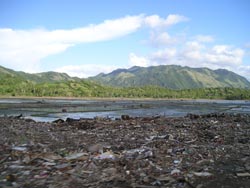
NSW salinity expertise aids tsunami-affected farmers

Former rice fields in Banda Aceh are now permanently
flooded.
Two Indonesian scientists working to restore soil fertility of tsunami affected land in Aceh visited NSW in January to learn about the latest research into growing crops on saline land.
Director of the Indonesian Soils Research Institute at Bogor, Dr Achmad Rachman, and a senior agronomist from Banda Aceh, Mr T. Iskandar, visited the north coast and Murray Irrigation Area as part of an Australian aid project led by the NSW Department of Primary Industries.
Project leader and soils scientist, Dr Peter Slavich, arranged for Dr Rachman and Mr Iskandar to inspect rain-fed and irrigated farming systems on the north coast and in the Murray Irrigation Area, as well as laboratory facilities at the Wollongbar Agricultural Institute.
The project is being funded by the Australian Centre for International Agricultural Research (ACIAR) to assist Indonesian agricultural research and extension services rehabilitate tsunami affected soils and restore cropping in east Aceh and Nias.
Dr Slavich said improving crop production on poorly drained and saline land is a problem common to both Acehnese and NSW farmers.
One of the first tasks of the NSW DPI project team was to train Indonesian researchers and extension staff to use an electromagnetic induction instrument (EM-38) to rapidly assess soil salinity.
EM technologies are widely used in Australia for salinity assessments.
Other DPI staff on the team are Dr Malem McLeod (hydrologist, Tamworth), Dr Natalie Moore (agronomist, Grafton) and Craig Hunt (laboratory technician, Wollongbar).
Dr Slavich said early assessments indicate that the most saline soils appear to be those where sea water lay for longest after the tsunami.
“These areas are also experiencing greater yield losses. There also appears to have been greater infiltration of salt water on sandier soils than some of the heavier and regularly puddled rice soils. This has salinised shallow well water.
“Our observations of rice crops in October indicated that water and nutrient management are critical.
Some rice crops had failed completely due to exposure to high water salinity early in their growth.
“Many also failed to fully fill grain so that farmers were only producing around 50% of their pre-tsunami yields.”
The tsunami on 26 December 2004 affected more than 2700 kilometres of coast around the Indian Ocean and inundated farming areas up to 5.5 km from the coast with ocean water.
The major crops on the Sumatran coast are irrigated rice, peanuts, soybeans and maize as well as a wide variety of vegetables.
Further information
Dr Peter Slavich, NSW DPI, Wollongbar, on 02 6626 1352 or peter.slavich@dpi.nsw.gov.au.
Email:

